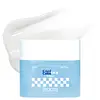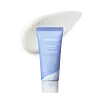What's inside
What's inside
 Key Ingredients
Key Ingredients

 Benefits
Benefits

 Concerns
Concerns

 Ingredients Side-by-side
Ingredients Side-by-side

Water
Skin ConditioningGlycerin
HumectantMethylpropanediol
Solvent1,2-Hexanediol
Skin ConditioningCaprylic/Capric Triglyceride
MaskingBetaine
HumectantHydrogenated Poly(C6-14 Olefin)
EmollientHydrogenated Polydecene
EmollientCentella Asiatica Extract
CleansingLaminaria Japonica Extract
Skin ProtectingEclipta Prostrata Leaf Extract
Skin ConditioningPhellodendron Amurense Bark Extract
Skin ConditioningTheobroma Cacao Seed Extract
AntioxidantAlbatrellus Confluens Extract
HumectantHydrogenated Lecithin
EmulsifyingSodium Hyaluronate
HumectantHydroxyethyl Acrylate/Sodium Acryloyldimethyl Taurate Copolymer
Emulsion StabilisingVinyldimethicone
Caprylyl Methicone
Skin ConditioningPolymethylsilsesquioxane
Acrylates/C10-30 Alkyl Acrylate Crosspolymer
Emulsion StabilisingHydroxyacetophenone
AntioxidantTromethamine
BufferingEthylhexylglycerin
Skin ConditioningGlyceryl Acrylate/Acrylic Acid Copolymer
HumectantDipropylene Glycol
HumectantAlcohol Denat.
AntimicrobialSorbitan Isostearate
EmulsifyingXanthan Gum
EmulsifyingFructooligosaccharides
HumectantBeta-Glucan
Skin ConditioningHydrolyzed Hyaluronic Acid
HumectantDextrin
AbsorbentButylene Glycol
HumectantTocopherol
AntioxidantSaccharomyces Ferment Filtrate
HumectantDimethylsilanol Hyaluronate
HumectantHydrolyzed Sodium Hyaluronate
Skin ConditioningAllantoin
Skin ConditioningPanthenol
Skin ConditioningPotassium Hyaluronate
Skin ConditioningHyaluronic Acid
HumectantSodium Hyaluronate Crosspolymer
HumectantHydroxypropyltrimonium Hyaluronate
Sodium Hyaluronate Dimethylsilanol
HumectantSodium Acetylated Hyaluronate
HumectantWater, Glycerin, Methylpropanediol, 1,2-Hexanediol, Caprylic/Capric Triglyceride, Betaine, Hydrogenated Poly(C6-14 Olefin), Hydrogenated Polydecene, Centella Asiatica Extract, Laminaria Japonica Extract, Eclipta Prostrata Leaf Extract, Phellodendron Amurense Bark Extract, Theobroma Cacao Seed Extract, Albatrellus Confluens Extract, Hydrogenated Lecithin, Sodium Hyaluronate, Hydroxyethyl Acrylate/Sodium Acryloyldimethyl Taurate Copolymer, Vinyldimethicone, Caprylyl Methicone, Polymethylsilsesquioxane, Acrylates/C10-30 Alkyl Acrylate Crosspolymer, Hydroxyacetophenone, Tromethamine, Ethylhexylglycerin, Glyceryl Acrylate/Acrylic Acid Copolymer, Dipropylene Glycol, Alcohol Denat., Sorbitan Isostearate, Xanthan Gum, Fructooligosaccharides, Beta-Glucan, Hydrolyzed Hyaluronic Acid, Dextrin, Butylene Glycol, Tocopherol, Saccharomyces Ferment Filtrate, Dimethylsilanol Hyaluronate, Hydrolyzed Sodium Hyaluronate, Allantoin, Panthenol, Potassium Hyaluronate, Hyaluronic Acid, Sodium Hyaluronate Crosspolymer, Hydroxypropyltrimonium Hyaluronate, Sodium Hyaluronate Dimethylsilanol, Sodium Acetylated Hyaluronate
Water
Skin ConditioningPropanediol
SolventGlycerin
HumectantPhenyl Trimethicone
Skin ConditioningMethyl Trimethicone
Skin Conditioning1,2-Hexanediol
Skin ConditioningTrehalose
HumectantDicaprylyl Carbonate
EmollientAmmonium Acryloyldimethyltaurate/Vp Copolymer
Hydrogenated Lecithin
EmulsifyingHydrogenated Polyisobutene
EmollientHydroxyethyl Acrylate/Sodium Acryloyldimethyl Taurate Copolymer
Emulsion StabilisingCetearyl Alcohol
EmollientAcrylates/C10-30 Alkyl Acrylate Crosspolymer
Emulsion StabilisingGlyceryl Caprylate
EmollientGlyceryl Stearate
EmollientTromethamine
BufferingDisodium EDTA
Ethylhexylglycerin
Skin ConditioningStearic Acid
CleansingPalmitic Acid
EmollientPolyglyceryl-3 Methylglucose Distearate
EmulsifyingSorbitan Isostearate
EmulsifyingMannitol
HumectantArginine
MaskingSerine
MaskingSucrose
HumectantPCA
HumectantCitrulline
Skin ConditioningGlycogen
HumectantHistidine Hcl
Skin ConditioningAlanine
MaskingTocopherol
AntioxidantHydroxypropyl Bispalmitamide Mea
EmollientThreonine
Glutamic Acid
HumectantMyristic Acid
CleansingArachidic Acid
CleansingLysine Hcl
Skin ConditioningAcrylates/Ammonium Methacrylate Copolymer
Cholesterol
EmollientSilica
AbrasiveWater, Propanediol, Glycerin, Phenyl Trimethicone, Methyl Trimethicone, 1,2-Hexanediol, Trehalose, Dicaprylyl Carbonate, Ammonium Acryloyldimethyltaurate/Vp Copolymer, Hydrogenated Lecithin, Hydrogenated Polyisobutene, Hydroxyethyl Acrylate/Sodium Acryloyldimethyl Taurate Copolymer, Cetearyl Alcohol, Acrylates/C10-30 Alkyl Acrylate Crosspolymer, Glyceryl Caprylate, Glyceryl Stearate, Tromethamine, Disodium EDTA, Ethylhexylglycerin, Stearic Acid, Palmitic Acid, Polyglyceryl-3 Methylglucose Distearate, Sorbitan Isostearate, Mannitol, Arginine, Serine, Sucrose, PCA, Citrulline, Glycogen, Histidine Hcl, Alanine, Tocopherol, Hydroxypropyl Bispalmitamide Mea, Threonine, Glutamic Acid, Myristic Acid, Arachidic Acid, Lysine Hcl, Acrylates/Ammonium Methacrylate Copolymer, Cholesterol, Silica
 Reviews
Reviews

Ingredients Explained
These ingredients are found in both products.
Ingredients higher up in an ingredient list are typically present in a larger amount.
1,2-Hexanediol is a synthetic liquid and another multi-functional powerhouse.
It is a:
- Humectant, drawing moisture into the skin
- Emollient, helping to soften skin
- Solvent, dispersing and stabilizing formulas
- Preservative booster, enhancing the antimicrobial activity of other preservatives
Acrylates/C10-30 Alkyl Acrylate Crosspolymer is a synthetic polymer. It is used to thicken and improve the texture of products. Due to its properties, it can prevent water and oil ingredients from separating.
Ethylhexylglycerin (we can't pronounce this either) is commonly used as a preservative and skin softener. It is derived from glyceryl.
You might see Ethylhexylglycerin often paired with other preservatives such as phenoxyethanol. Ethylhexylglycerin has been found to increase the effectiveness of these other preservatives.
Glycerin is already naturally found in your skin. It helps moisturize and protect your skin.
A study from 2016 found glycerin to be more effective as a humectant than AHAs and hyaluronic acid.
As a humectant, it helps the skin stay hydrated by pulling moisture to your skin. The low molecular weight of glycerin allows it to pull moisture into the deeper layers of your skin.
Hydrated skin improves your skin barrier; Your skin barrier helps protect against irritants and bacteria.
Glycerin has also been found to have antimicrobial and antiviral properties. Due to these properties, glycerin is often used in wound and burn treatments.
In cosmetics, glycerin is usually derived from plants such as soybean or palm. However, it can also be sourced from animals, such as tallow or animal fat.
This ingredient is organic, colorless, odorless, and non-toxic.
Glycerin is the name for this ingredient in American English. British English uses Glycerol/Glycerine.
Learn more about GlycerinHydrogenated Lecithin is created from the hydrogenation of lecithin (a group of phospholipids). Hydrogenation is a chemical reaction between hydrogen and another element.
This ingredient is an emollient and emulsifier. As an emollient, it helps soften skin by trapping moisture within. As an emulsifier, it prevents oil and water ingredients from separating.
This is a synthetic polymer. It helps improve the texture of products by adding thickness and gel-like feel.
It is also an emulsifer, meaning it prevents ingredients such as oil and water from separating. It also helps evenly disperse other ingredients.
Sorbitan Isostearate is an emulsifer and cleaning agent. It is created from isostearic acid and sorbitol.
As an emulsifier, Sorbitan Isostearate prevents oils and water from separating.
Due to its isostearic acid base, it may not be safe for Malassezia or fungal acne.
Learn more about Sorbitan IsostearateTocopherol (also known as Vitamin E) is a common antioxidant used to help protect the skin from free-radicals and strengthen the skin barrier. It's also fat soluble - this means our skin is great at absorbing it.
Vitamin E also helps keep your natural skin lipids healthy. Your lipid skin barrier naturally consists of lipids, ceramides, and fatty acids. Vitamin E offers extra protection for your skin’s lipid barrier, keeping your skin healthy and nourished.
Another benefit is a bit of UV protection. Vitamin E helps reduce the damage caused by UVB rays. (It should not replace your sunscreen). Combining it with Vitamin C can decrease sunburned cells and hyperpigmentation after UV exposure.
You might have noticed Vitamin E + C often paired together. This is because it is great at stabilizing Vitamin C. Using the two together helps increase the effectiveness of both ingredients.
There are often claims that Vitamin E can reduce/prevent scarring, but these claims haven't been confirmed by scientific research.
Learn more about TocopherolTromethamine helps balance the pH and improve the texture of a product. It is synthetically created.
As an emulsifier, Tromethamine prevents oil and water ingredients from separating. This helps stabilize the product and elongate a product's shelf life. Tromethamine also makes a product thicker.
Tromethamine helps balance the pH level of a product. Normal pH level of skin is slightly acidic (~4.75-5.5). The acidity of our skin is maintained by our glands and skin biome. Being slightly acidic allows our skin to create an "acid mantle". This acid mantle is a thin barrier that protects our skin from bacteria and contaminants.
Oral Tromethanmine is an anti-inflammatory drug but plays the role of masking, adding fragrance, and/or balancing pH in skincare.
1,3-Propanediol, 2-amino-2-(hydroxymethyl)-
Learn more about TromethamineWater. It's the most common cosmetic ingredient of all. You'll usually see it at the top of ingredient lists, meaning that it makes up the largest part of the product.
So why is it so popular? Water most often acts as a solvent - this means that it helps dissolve other ingredients into the formulation.
You'll also recognize water as that liquid we all need to stay alive. If you see this, drink a glass of water. Stay hydrated!
Learn more about Water